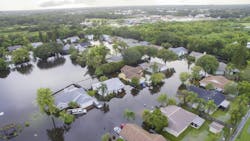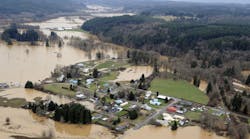Urban flood resilience has become a critical concern as cities worldwide face an increasing threat of flooding due to climate change, urbanization and aging infrastructure. With more frequent and severe storm events, urban areas are particularly vulnerable to significant economic and social disruptions. Flood resilience is essential to mitigate these impacts and ensure communities can better withstand and recover from flood events.
By implementing advanced strategies and technologies, cities can enhance their capacity to manage stormwater effectively, protect valuable assets and safeguard residents’ well-being. Investing in flood resilience reduces immediate risks and fosters long-term sustainability in changing environmental conditions.
Advanced urban flood risk assessment
Precise flood risk mapping is crucial as urban populations continue to increase. Currently, 4.4 billion people live in cities, and by 2050, nearly 70% of the world’s population will likely reside in urban areas. This concentration of people and infrastructure heightens the need for accurate flood risk assessments to protect lives and property.
Precise mapping helps identify vulnerable areas, guide urban planning and prioritize investments in flood mitigation measures. This ensures communities use resources effectively to minimize the impact of flooding events.
Advanced technologies such as light detection and ranging (LiDAR) and geographic information systems (GIS) are essential for detailed flood modeling. LiDAR provides high-resolution topographic data to enable accurate terrain analysis. Meanwhile, GIS integrates various data sources for comprehensive flood modeling.
Additionally, incorporating climate change projections into risk assessments allows cities to anticipate future flood risks and adapt their strategies accordingly. This proactive approach ensures urban areas remain resilient despite evolving environmental challenges, safeguarding communities and fostering sustainable development.
Innovative stormwater management techniques
Ingenious stormwater management efforts are essential for urban areas to handle increased rainfall and reduce flood risks. By incorporating these solutions, cities can efficiently manage stormwater and enhance flood resilience.
Green infrastructure
Green infrastructure — such as green roofs, rain gardens and permeable pavements — offers significant benefits by reducing and treating stormwater at its source while delivering environmental, social and economic advantages.
Green roofs absorb rainfall to reduce runoff and provide insulation, while rain gardens filter pollutants and enhance urban biodiversity. Porous pavements, on the other hand, allow water to infiltrate through surfaces, decreasing surface runoff and recharging groundwater.
These solutions help mitigate flood risks, improve water quality, and create more sustainable and livable urban environments. Additionally, they enhance aesthetic appeal, provide recreational spaces and can increase property values. These advantages make them a multifaceted approach to urban stormwater management.
Underground Storage Solutions
Implementing underground reservoirs and cisterns in urban areas provides a strategic solution for managing stormwater effectively. These systems store excess rainfall during heavy storms, reducing flooding risks and preventing overflow in sewer systems. Capturing and holding stormwater lets underground reservoirs and cisterns slowly release it into the environment or reuse it for non-potable purposes like irrigation and industrial processes.
This process mitigates flood risks and promotes water conservation. Additionally, these systems are concealed underground, maximizing land use without altering the urban landscape. This approach makes them efficient and unobtrusive for enhancing urban flood resilience.
Smart drainage systems
Real-time monitoring and automated control of stormwater systems are critical for managing heavy runoff and preventing contamination of drinking water, including public utilities and private wells. During flooding events, untreated runoff can carry pollutants compromising water quality and pose serious health risks.
Effective stormwater systems utilizing real-time data and automated controls can swiftly respond to changing conditions. These innovations can optimize water flow and storage to prevent overflows and contamination.
This proactive approach ensures water supplies remain safe and reliable, which is crucial given that less than a week without access to clean drinking water can be fatal. By leveraging technology, cities can enhance their resilience to flood-related water quality issues and safeguard public health.
Enhancing natural waterways
Restoring urban streams and rivers has become increasingly crucial as dozens of major cities in the U.S. have experienced a rise in flood days over the last decade. Revitalizing these natural waterways helps manage stormwater more effectively by enhancing its capacity to absorb and convey excess water.
Restoration efforts often involve removing concrete channels, reestablishing natural flow patterns and improving habitat conditions. These processes reduce flood risks, boost urban biodiversity and create recreational community spaces.
Moreover, incorporating riparian buffer zones and constructing wetlands are essential to these restoration projects. Riparian buffer zones — designed with native vegetation along riverbanks — filter pollutants, stabilize banks and provide wildlife habitat. These buffers also enhance the aesthetic value of urban waterways and offer green spaces for residents.
Wetland construction and maintenance in urban settings support flood management by acting as natural sponges that absorb and slowly release stormwater. These wetlands improve water quality, recharge groundwater and provide critical ecosystems within urban landscapes, making them vital for building resilient and sustainable cities.
Community-Based Urban Flood Resilience
Community engagement, education, and incentive programs are essential strategies for building urban flood resilience. Since 2000, flooding has cost taxpayers over $850 billion, and since 1980, the total has surpassed $1 trillion. Educating residents about flood risks and mitigation measures empowers communities to take proactive steps, such as installing flood barriers or rain gardens on their properties.
Local governments are pivotal in promoting community resilience by implementing policies encouraging these practices and offering financial incentives or grants for flood-proofing homes and businesses. Through public awareness, supportive policies and financial assistance, cities can enhance their collective ability to withstand and recover from flood events and reduce the economic burden on taxpayers.
Policy and regulatory frameworks
Existing flood management policies are crucial in enhancing urban flood resilience. The federal government has deployed $3.5 billion in flood mitigation assistance grants to improve community flood resilience and an additional $2.6 billion in climate investments. Integrating this aspect into urban planning regulations creates sustainable and safe communities. It ensures new developments and infrastructure can withstand flooding events.
Successful policy implementations — such as stricter building codes in flood-prone areas and the promotion of green infrastructure — have significantly reduced flood damage and improved water management. These policies protect lives and property and promote long-term economic and environmental sustainability. Learning from these examples, other cities can adopt similar strategies to enhance their resilience.
Driving forward with innovation and adaptation
Continued innovation and adaptation are vital for urban communities to manage increasing flood risks effectively. Stormwater professionals must implement advanced strategies and technologies to ensure resilient and sustainable urban environments for the future.
About the Author
Emily Newton
Editor -in-chief
Emily Newton is editor-in-chief of Revolutionized. Newton can be reached at [email protected].



